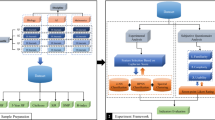Abstract
Here we study the relationship between journal quartile rankings of ISI impact factor (at the 2010) and journal classification in four impact classes, i.e., highest impact, medium highest impact, medium lowest impact, and lowest impact journals in subject category computer science artificial intelligence. To this aim, we use fuzzy maximum likelihood estimation clustering in order to identify groups of journals sharing similar characteristics in a multivariate indicator space. The seven variables used in this analysis are: (1) Scimago Journal Ranking (SJR); (2) H-Index (H); (3) ISI impact factor (IF); (4) 5-Year Impact Factor (5IF); (5) Immediacy Index (II); (6) Eigenfactor Score (ES); and (7) Article Influence Score (AIS). The fuzzy clustering allows impact classes to overlap, thereby accommodating for uncertainty related to the confusion about the impact class attribution for a journal and vagueness in impact classes definition. This paper demonstrates the complex relationship between quartiles of ISI impact factor and journal impact classes in the multivariate indicator space. And that several indicators should be used for a distinct analysis of structural changes at the score distribution of journals in a subject category. Here we propose it can be performed in a multivariate indicator space using a fuzzy classifier.






Similar content being viewed by others
References
Abonyi, J., Balasko, B., & Feil B. (2011). Fuzzy clustering and data analysis toolbox. Department of Process Engineering at the University of Veszprem, Hungary. http://www.fmt.vein.hu/softcomp/fclusttoolbox. Accessed June 2011.
Adam, D. (2002). The counting house. Nature, 415, 726–729.
Bergstrom, C. (2007). Eigenfactor: Measuring the value and prestige of scholarly journals. College and Research Libraries News, 68(5), 314–316.
Bezdek, J. C., & Dunn, J. C. (1975). Optimal fuzzy partitions: A heuristic for estimating the parameters in a mixture of normal distributions. IEEE Transactions on Computers, 24(8), 835–838.
Bollen, J., Rodriguez, M. A., & van de Sompel, H. (2006). Automatic metadata generation using associative networks. Scientometrics, 69(3), 669–687.
Burrough, P. A., & McDonnell, R. A. (1998). Principles of geographical information systems. Principles of geographical information systems. Oxford: Oxford University Press.
Butler, L. (2004). What happens when funding is linked to publication counts?. In H. F. Moed (Ed.), Handbook of quantitative science and technology research (pp. 389–405). Dordrecht: Kluwer.
Comisión Nacional Evaluadora de la Actividad Investigadora (CNEAI). (2011). http://www.educacion.gob.es/horizontales/ministerio/organismos/cneai.htm. Accessed June 2011.
Duda, R. O., Hart, P. E., & Stork, D. G. (2001). Pattern classification (2nd Ed., p. 680). New York: Wiley.
Dunn, J. C. (1973). A fuzzy relative of the isodata process and its use in detecting compact well separated clusters. Journal of Cybernetics, 28, 32–57.
Fisher, P., & Wood, J. (1998) What is a Mountain? Or the Englishman who went up a Boolean geographical concept but realised it was fuzzy. Geography, 83, 247–256.
Garfield, E. (2006). The history and meaning of the journal impact factor. JAMA—Journal of the American Medical Association, 295(1), 90–93.
Gath, I., & Geva, A. B. (1989). Unsupervised optimal fuzzy clustering. IEEE Transactions on Pattern Analysis and Machine Intelligence, 11, 773–781.
González-Pereira, B., Guerrero-Bote, V. P., & Moya-Anegón, F. (2010). A new approach to the metric of journals’ scientific prestige: The SJR indicator. Journal of Informetrics, 4(3), 379–391.
Hirsch, J. E. (2005). An index to quantify an individual’s scientific research output. PNAS, 102(46), 16569–16572. doi:10.1073/pnas.0507655102.
Jiménez-Contreras, E., Moya-Anegón, F., & López-Cózar, E. (2003). The evolution of research activity in Spain: The impact of the National Commission for the Evaluation of Research Activity (CNEAI). Research Policy, 32, 123–142.
Journal Citation Reports. (2011). Thomson Reuters. http://thomsonreuters.com/products_services/science/science_products/a-z/journal_citation_reports. Accessed June 2011.
Kalaitzidakis, P., Thanasis, S., & Mamuneas, T. P. (2003). Rankings of academic journals and institutions in economics. Journal of the European Economic Association, 1(6), 1346–1366.
Kodrzycki, Y. K., & Yu, P. (2006). New approaches to ranking economics journals. Contributions to Economic Analysis and Policy, 5(1), article 24.
Leydesdorff, L., Moya-Anegón, F., & Guerrero-Bote, V. P. (2010). Journal maps on the basis of Scopus data: A comparison with the Journal Citation Reports of the ISI. Journal of the American Society for Information Science and Technology, 61, 352–369.
Liebowitz Stanley, J., & Palmer, J. P. (1984). Assessing the relative impacts of economics journals. Journal of Economic Literature, 1, 77–88.
Ma, N., Guan, J., & Zhao, Y. (2008). Bringing PageRank to the citation analysis. Information Processing and Management, 44(2), 800–810.
McBratney, A. B., de Gruijter, J. J., & Brus, D. J. (1992). Spatial prediction and mapping of continuous soil classes. Geoderma, 54, 39–64.
McBratney, A. B., & Odeh, I. O. A. (1997). Application of fuzzy sets in soil science: Fuzzy logic, fuzzy measurements and fuzzy decisions. Geoderma, 77, 85–114.
OECD. (2010). In Performance-based funding for public research in tertiary education institutions: Workshop proceedings. OECD Publishing. http://dx.doi.org/10.1787/9789264094611-en.
Palacios-Huerta, I,, & Volij, O. (2004). The measurement of intellectual influence. Econometrica, 72(3), 963–977.
Pinski, G., & Francis, N. (1976). Citation influence for journal aggregates of scientific publications. Information Processing and Management, 12, 297–312.
Rousseau, S., Verbeke, T., & Rousseau, R. (2009). Evaluating environmental and resource economics journals: A TOP-curve approach. Review of Environmental Economics and Policy 3(2), 270–287.
SCImago Journal and Country Rank. (2011). SCImago Research Group. http://www.scimagojr.com. Accessed June 2011.
van Raan Anton, F. J. (2004). Measuring science. In F. Moed Henk, G. Wolfgang, & S. Ulrich (Eds.), Handbook of quantitative science and technology research (pp. 19–50). Dordrecht: Kluwer.
Acknowledgments
This research was sponsored by the Spanish Board for Science and Technology (MICINN) under grant TIN2010-15157 cofinanced with European FEDER funds. Thanks are due to the reviewers for their constructive suggestions.
Author information
Authors and Affiliations
Corresponding author
Rights and permissions
About this article
Cite this article
García, J.A., Rodriguez-Sánchez, R., Fdez-Valdivia, J. et al. On first quartile journals which are not of highest impact. Scientometrics 90, 925–943 (2012). https://doi.org/10.1007/s11192-011-0534-3
Received:
Published:
Issue Date:
DOI: https://doi.org/10.1007/s11192-011-0534-3




